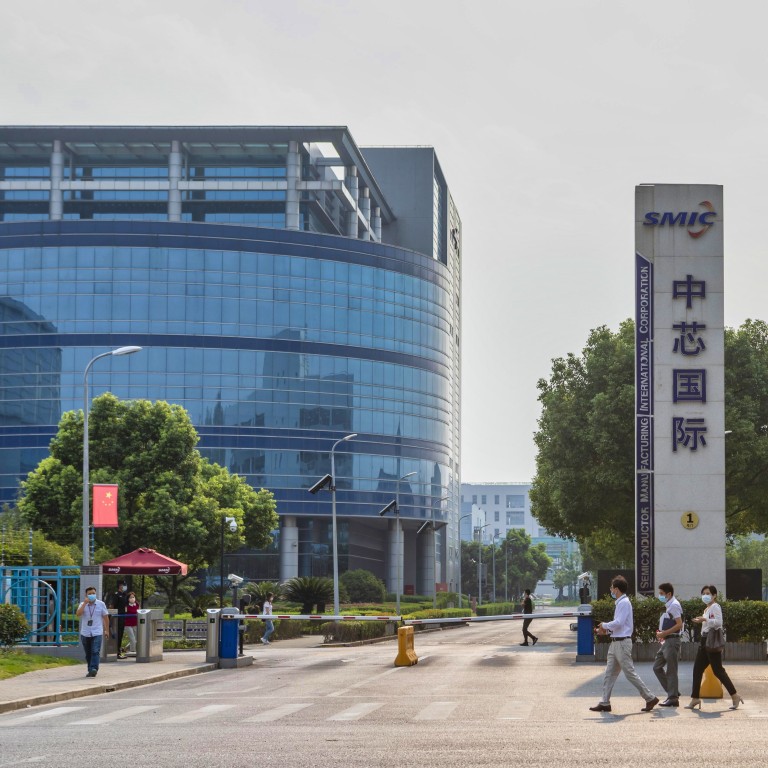
China’s semiconductor industry sees 5G, AI applications driving opportunities for domestic substitutes amid US tech restrictions, says KPMG
- The Chinese semiconductor industry will maintain ‘sound and continuous’ growth and achieve partial self-reliance over time, according to KPMG
- China still relies heavily on key tech components from the West, resulting in a self-sufficiency rate of less than 20 per cent
“The Covid-19 pandemic has spurred market demand for 5G chips, memory chips and logic semiconductor products,” said Jamie Li, partner at KPMG’s integrated chips intelligence industry group in Shanghai.
Speaking on the sidelines of the 3rd China International Import Exposition in Shanghai on Friday, Li said that despite US tech sanctions the Chinese semiconductor industry will maintain “sound and continuous” growth and achieve partial self-reliance over time, adding that achieving total self-reliance was unrealistic for any country or company.
“China has a huge consumer market to make technologies originating from universities and research institutes come to fruition,” Li said. In particular, the country could achieve breakthroughs because of new opportunities emerging from 5G and artificial intelligence applications.
Speaking at the same event, KPMG vice-president Gong Weili said China was at a critical stage of achieving technology breakthroughs. “How to strengthen technological innovation and enhance overall competitiveness is a broad focus of the industry,” he said.
Latest US export controls further hamstring China’s semiconductor ambitions
China has been galvanised to achieve more self-reliance in key technologies such as semiconductors, the bedrock of its digital economy, after the US leveraged its clout in the global semiconductor supply chain to curb the rise of Chinese tech champions like Huawei Technologies and Semiconductor Manufacturing International Corp (SMIC).
Last week, Beijing stressed an innovation-driven development strategy in its proposed 14th Five-Year Plan, which includes proposals to strengthen the nation by building robust technologies. China still relies heavily on key tech components from the West, resulting in a self-sufficiency rate of less than 20 per cent, according to a report from Deloitte.
The Chinese semiconductor industry has grown significantly in 2020 on the back of major investments from government funds and the private sector, according to KPMG, which on Friday released its Chiptech list of 50 nascent private semiconductor start-ups that have potential for growth due to their “good patents and products”.
More than 70 per cent of the 50 companies on the list originate from the Yangtze River Delta region, which includes Shanghai as well as the provinces of Jiangsu, Zhejiang and Anhui. Shanghai, where SMIC is headquartered, accounts for 20 of those companies.
Li said local government policies and incentives and a full-fledged ecosystem have favoured the development of the semiconductor sector, which has been able to attract and train a large number of talented people.
Why semiconductors are important in the US-China tech war
Despite tech sanctions imposed by the US, KPMG said most of the industry participants it surveyed were optimistic about prospects for China’s future semiconductor development because of the size of the country’s market in the global semiconductor supply chain.
The rosy outlook was echoed by ASML, the world’s leading supplier of critical lithography systems for chip making, which said it saw China as an important market as it weighs more hiring to support expansion in the Chinese market.
In 2020, ASML’s proportion of revenue from China will double to 20 per cent of total revenue from 10 per cent last year, according to a company spokesman who spoke at the company’s display booth and requested anonymity. The company has shipped a cumulative total of 700 lithography systems to Chinese customers such as SMIC, Shanghai Hua Hong Semiconductor and Yangtze Memory Technologies, he added.
“We are planning to hire more people in China to support our clients and are considering building new offices in southwest China,” he said.

